Whether it be a sign that reads “No beverage or ice cream in seating area,” or a piece of the original hardwood up for display, the effort to keep the Muncie Fieldhouse’s legacy alive is evident by its entryway alone.
Then, once the wooden doors open to reveal nine state championship banners hanging high above the giant purple Bearcat at center court, the landmark looks just as it did decades ago. Holding its first game in the winter of 1928, the Fieldhouse is among the five oldest high school gymnasiums in Indiana still in regular use.
With a capacity of 7,000+, it was the largest high school gym in the world, before that title was first taken by the New Castle Fieldhouse just 21 minutes away. Nearing its 100th birthday, the Muncie Fieldhouse continues to be celebrated by community members, alumni and current players or staff.
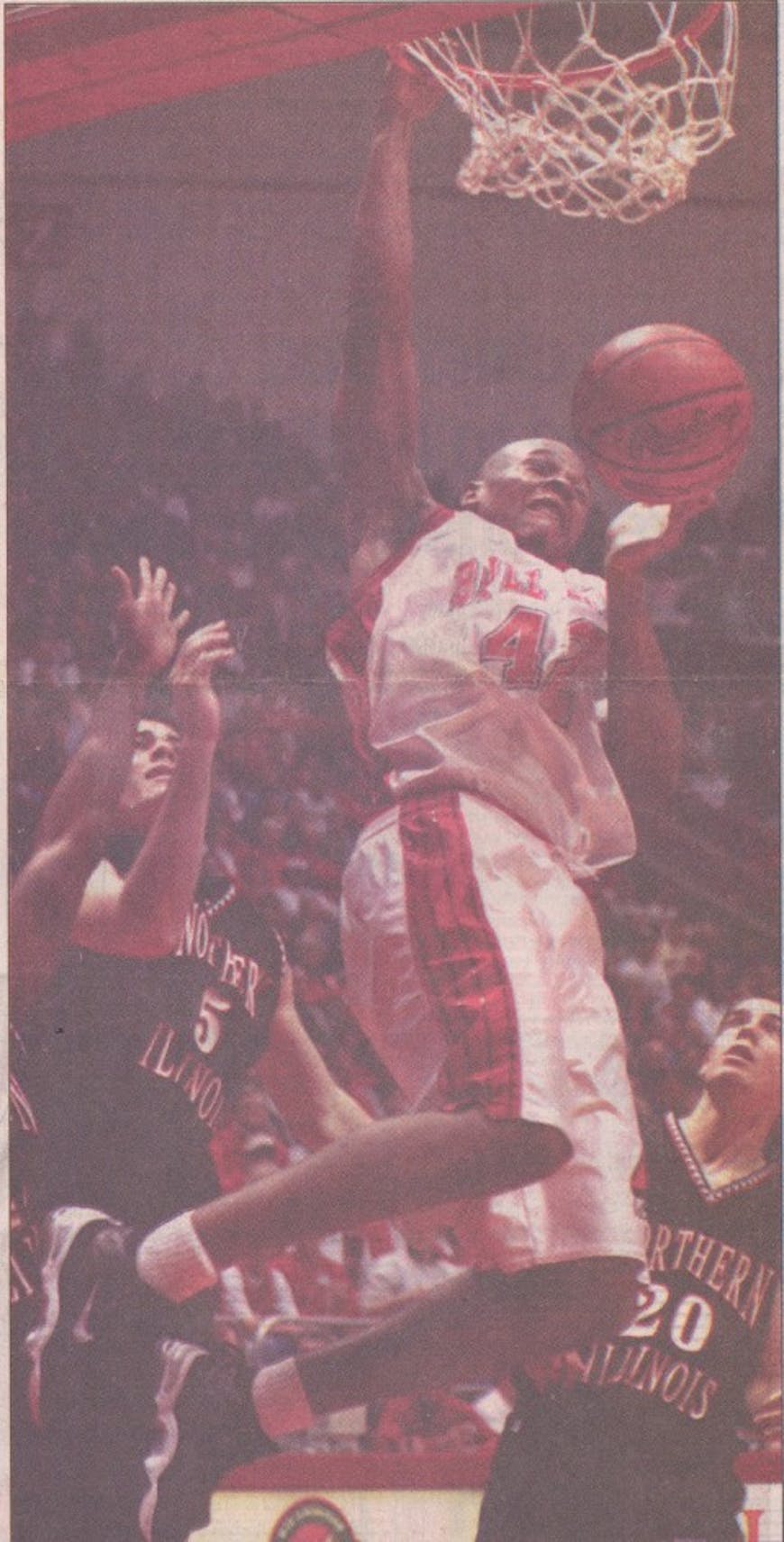
In this photo from the Feb. 23, 1998, issue of The Daily News, former Ball State forward on the Bonzi Wells makes a one-handed dunk to break the former Mid-American Conference scoring record of 2,377 points. The previous record was held by Ron Harper. Carrie Wadycki, DN File
Bonzi Wells
“I remember when I fell in love with basketball,” Wells said.
It was 1988. The Muncie native was in elementary school, and Bonzi’s dad, Gawen, wanted to take him to a basketball game.
“I remember walking in there and seeing the sea of Purple and White wall to wall,” Wells said. “The school spirit, the mascot, the cheerleaders dancing, the band playing. And then seeing Chandler [Thompson], Victor Young and Cedric Vanleer — that whole crew just put on a show.”
Even at his young age, Wells was inspired.
“I looked around and thought, ‘This is what I want to do,’” Wells said.
His next step was to meet his idol, then head coach Bill Harrell. Wells often saw Harrell, complete with a cigar in his mouth, in the local newspapers and made him out to be the face of Muncie Central boys’ basketball.
Just as Wells’ freshman year of high school began, he remembered Harrell calling him by name into his office. Wells said Harrell handed him a room-temperature bottle of Coca-Cola, and Wells knew he was set up for success.
“It gives me chills right now just thinking about walking down that hall to his office,” Wells said. “In that moment I told myself, ‘I would run through a wall for this man.’”
It was two years before Wells ever suited up for the Bearcats’ varsity squad, but making the freshman ‘B’ team after being cut from his 8th grade was a landmark moment in the future NBA player’s life.
“I went home, I put the whole uniform on my bed, and I stood and stared at it for hours,” Wells said. “I told myself from that moment on, ‘I'm going to do my best in this uniform.’”
Wells made an eventual impact for the Bearcats, helping lead Muncie Central to a 24-2 record in his senior season. With that success came unrivaled support from the community.
“It was a great time to be alive and be a Muncie Central basketball player,” Wells said. “When you get that type of support, you don't want to let the community down, because it seemed like when a Muncie Central game was going on, all of Muncie was shut down.”
Wells used this success to transition into a four-season career at Ball State University, earning Mid-American Conference (MAC) Player of the Year honors three times before being selected with the 11th overall pick in the 1998 NBA Draft.
Once he made it to the association, spending 10 seasons there, he said he felt well-prepared for the bright lights of professional arenas due to his experience in the Muncie Fieldhouse.
Wells said when he was last in Muncie in December 2023, he wanted to take his sons to the Fieldhouse to get shots up. Calling the venue his “safe haven,” the Muncie native said he never feels more at home than when he’s at the Fieldhouse.
“It’s the symbol of the city,” Wells said. “It's therapeutic in there … If it wasn’t for Muncie Central and that Fieldhouse, I don’t know where I would be.”
However, Wells said his symbolic home is missing a key characteristic: a lasting personal legacy, documented in photos. Though he was sure to explain that he doesn’t want recognition for himself, he wants it for local kids who are aspiring Bearcats like he was.
“I want them to truly understand that a guy from these streets and these neighborhoods made it to the top of the field coming from this exact gym,” Wells said. “I bleed purple.”
Ray McCallum
Just two numbers in the history of Ball State basketball are hanging in the rafters of Worthen Arena, retired from further use. One is Wells, the other is McCallum, both of whom attended Muncie Central and spent their youth putting on a show in the Fieldhouse.
In fact, the two all-time leading scorers for Ball State men’s basketball were raised on the same street: Macedonia Avenue.
“When you grew up, you wanted to be a Muncie Central Bearcat,” McCallum said.
Their high school journey’s even started similarly when McCallum didn’t make the varsity squad until his junior season. Yet unlike Wells, McCallum had prior experience playing in the Fieldhouse before making it to high school as the historic venue played host to many middle school and recreational games during his youth.
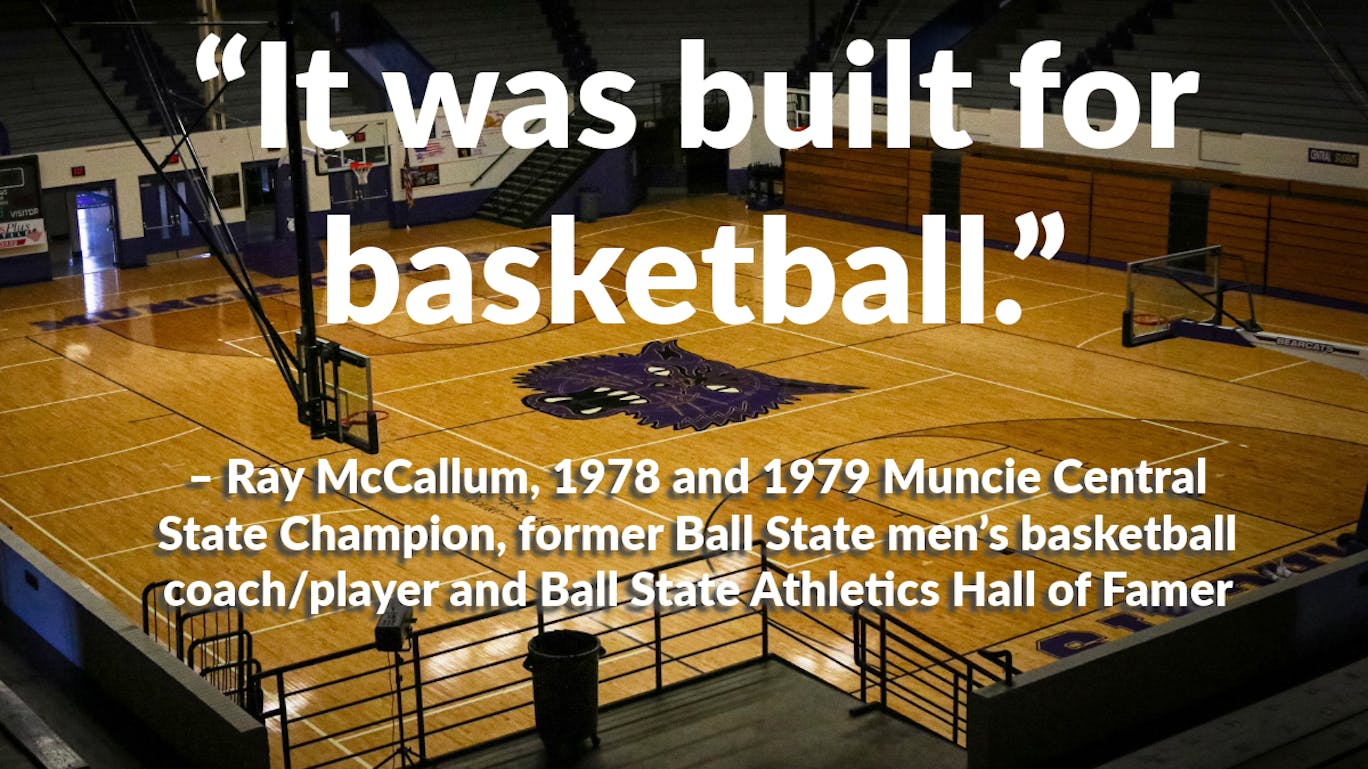
“That’s probably why I shot the ball so well in the Fieldhouse,” McCallum said.
In his two seasons as a varsity starter, McCallum led the Bearcats to two consecutive State Championships in 1978 and 1979. Recalling the community support that came with the historic seasons, McCallum called Muncie “the place to be” in the late 1970s. Of course, the most common gathering place of those supporting the Bearcats was the Fieldhouse, a “landmark” in McCallum’s eyes.
“It was built for basketball,” McCallum said. “It’s a great floor, a great shooting background, you had on-court seating, you had the balcony, but it was still in close where the fans were right there by the action. That made it really tough for our opponents.”
When McCallum was being recruited by multiple universities to play college basketball, he said Harrell, his head coach, encouraged him to choose Ball State due to the familiarity McCallum had with the Muncie community and its love for basketball. That decision paid off, as McCallum earned MAC Player of the Year in 1983 en route to one of the most successful careers in program history.
He forayed this into a 40-year coaching career, one he still enjoys as associate head coach at Tulane. However, before his head coaching tenures at Detroit Mercy and the University of Houston, McCallum was Ball State’s head honcho from 1993-2000.
His first recruit? Bonzi Wells.
Jeff Holloway
When Muncie Central’s current athletic director and 1994 Muncie Central graduate thinks of his time playing at the Muncie Fieldhouse, he doesn’t remember many individual games or scores. He was more amazed at the sights and sounds.
“I remember running out of the locker room and it was just electric,” Holloway said. “You smelled the popcorn, the band was rocking, and then you saw the purple.”
One game Holloway does remember was a contest against North Central Conference (NCC) rival Marion for the NCC title his senior year.
Just a few months before Reggie Miller’s iconic ‘Choke Game’ at Madison Square Garden against the New York Knicks in the NBA Eastern Conference Finals, the Indiana Pacers legend traveled to the Muncie Fieldhouse to watch the Bearcats. But that was the prominence of Muncie Central basketball at the time, Holloway said.
Just like the Pacers failed to reach the NBA Finals with a 4-3 series loss to the Knicks, Muncie Central’s 24-2 season ended with a loss to Ben Davis in the Semi State Championship, just 12 points away from heading back to the State Finals for the first time since winning the title in 1988.
When Holloway played at Arkansas State in college and overseas professionally for more than five years, he said when he showed his teammates photos of the gym, they couldn’t believe a venue of its size was home to high school sports.
Now, Holloway has had the chance to regularly occupy the Fieldhouse in three different roles: player, coach and administrator. When he was head coach of the Bearcats for three seasons from 2014-17, he said he was finally able to appreciate the historic venue in a way he didn’t as a player.
Even though Holloway said he wants to use his current role as a chance to introduce modern characteristics to the Fieldhouse, such as adding video scoreboards in the corners of the gymnasium, he wants to be sure not to take away from the history of the building.
“It’s a sacred place,” Holloway said.
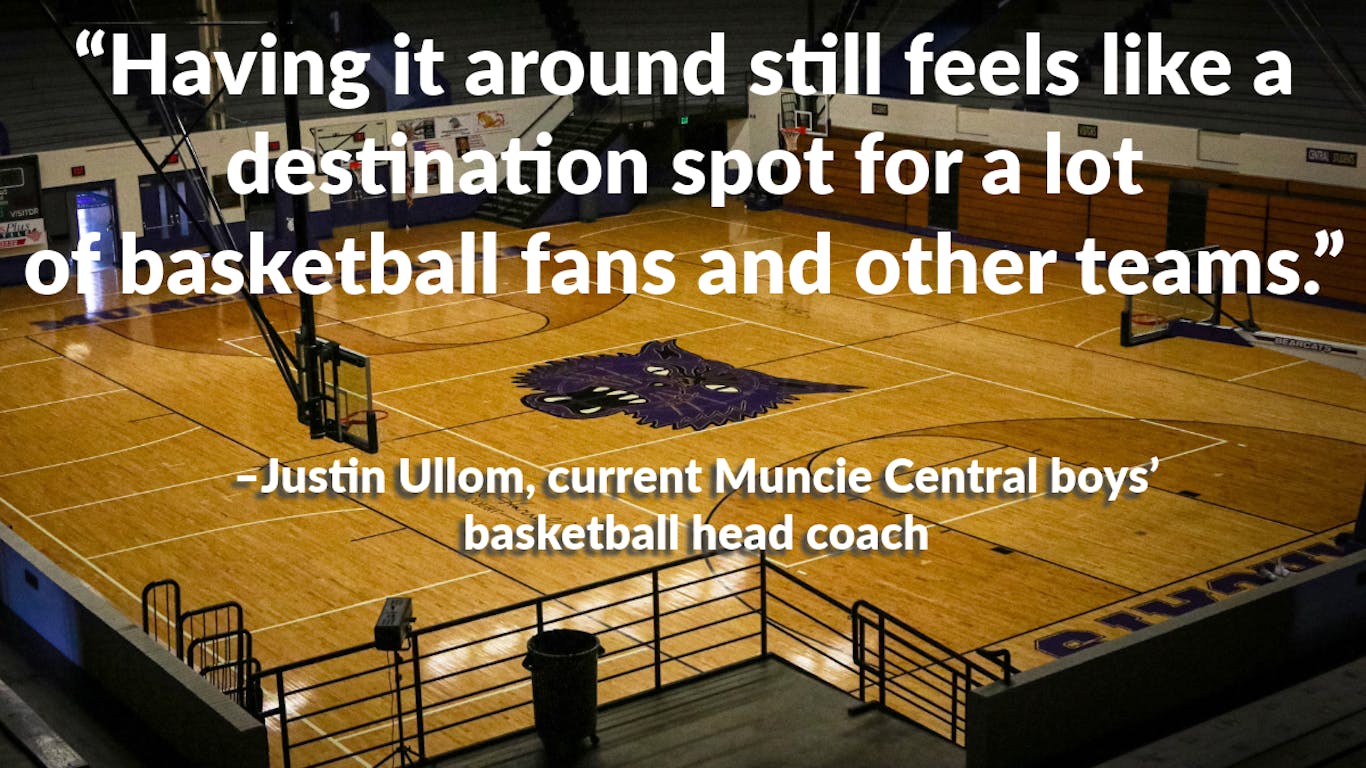
Justin Ullom
The current Muncie Central boys’ basketball head coach never played a sanctioned game at the Muncie Fieldhouse despite graduating from Delta High School in 1996. The only time he was able to get shots up in the landmark venue was during an annual preseason ‘jamboree’ hosted by Muncie Central with local schools like Yorktown and Delta invited and at a local All-Star Game during his senior season.
Even though he had limited opportunities to take the historic hardwood as a player, he dreamed of playing at the Fieldhouse during his childhood. Now, he spends numerous hours every week in the hallowed grounds.
“Muncie Central is, and always has been, the program,” Ullom said. “To now be one of the stewards of the program, [we’re] trying to honor the past players and coaches that have come before us and see if we can do it the right way.”
Formerly the boys’ basketball head coach for eight seasons just 12.3 miles away from the Fieldhouse at Monroe-Central, Ullom is all too familiar with how fast high school goes by as a student-athlete. His main objective with the current and future crop of Bearcats he leads is to help them not take their home court for granted.
“We’d like to get them in there while they’re young to start that desire and fascination with the fieldhouse and one day be able to wear the Purple and White,” Ullom said.
Rick Jones
Unlike Ullom, Jones has not always called Muncie home. Born in Alexandria, Indiana, before moving to Redkey, Indiana, Jones didn’t enroll at Muncie Central until 9th grade.
Little did he or anyone else know that in just three years' time, he would have one of the most successful seasons in Muncie Central history. In the 1962-63 season, Jones won the Indiana Mr. Basketball Award, the third and most recent Bearcat to earn the honor.
Jones remembered one of his keys to success while playing at the Fieldhouse, claiming one of the corners of the court sagged and provided him with extra boost whenever he took a jump shot.
“I loved to go over to that corner and shoot, because I felt like I was jumpin’ higher,” Jones said.
Perhaps more important to Jones, he led the Bearcats to their fifth state championship in program history that same season. Calling Muncie Central boys’ basketball ‘the top of the hill’ during his tenure in the Purple and White, Jones remembers local fire marshals having to turn away excess fans at most home games as the Fieldhouse was filled to capacity.
In fact, individual tickets for games were not sold at the gate during this time period. Instead, fans who wanted to go to games had to buy season tickets prior to the beginning of a campaign.
Now residing in Anderson, Indiana, Jones said he doesn’t go to the Fieldhouse often, but he recently went to watch his son, Bobby, coach New Castle girls’ basketball in his old stomping grounds.
“It should always be there,” Jones said. “It was the heart of Muncie Central.”
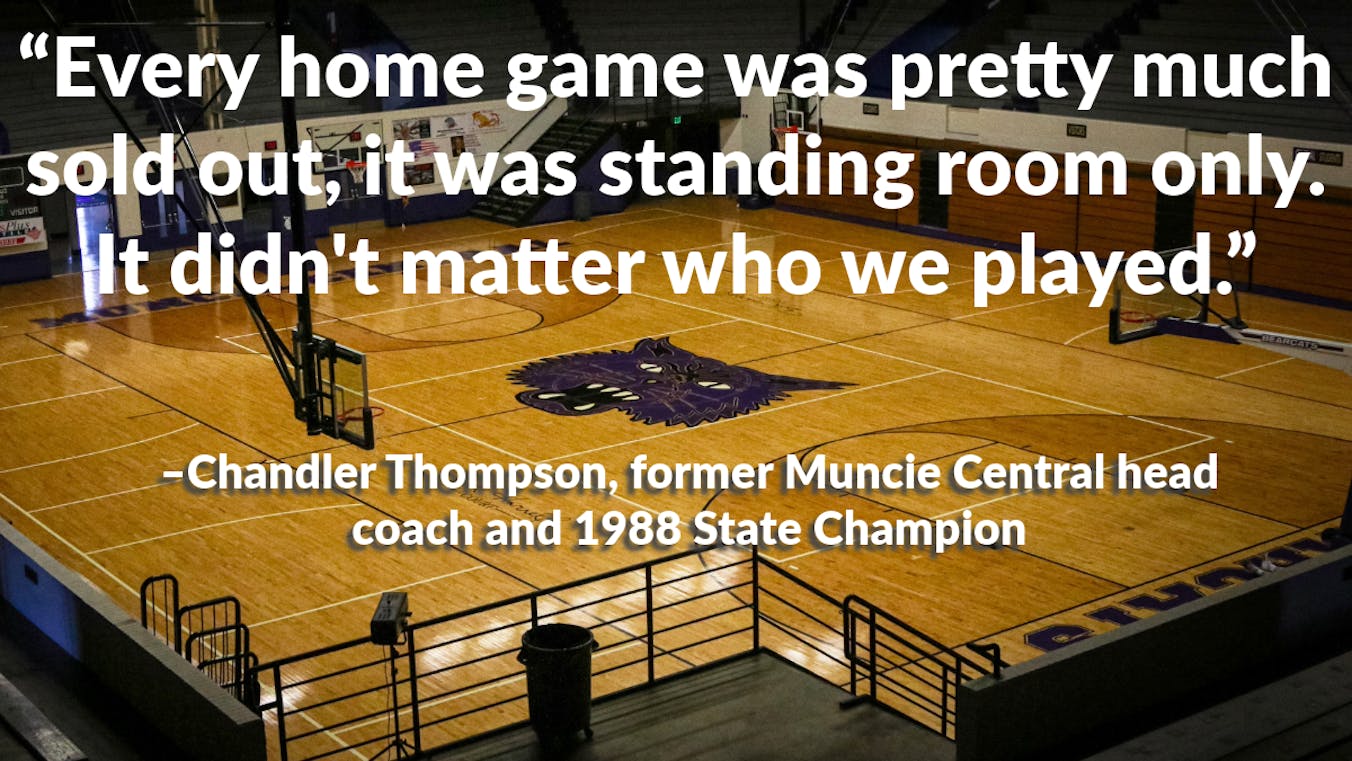
Chandler Thompson
To most Ball State followers, the moment that put Thompson on the map was his putback dunk against the University of Nevada-Las Vegas (UNLV) in the Sweet 16 of the 1990 NCAA Tournament. However, his love for basketball began in the Muncie Fieldhouse.
Thompson said a 1982 matchup between Muncie Central and Marion, showcasing the Giants’ James Blackmon and Joseph Price, was the moment he knew he wanted to play basketball long-term.
Like Jones, Thompson’s first time playing on the Fieldhouse’s hardwood was for McKinley Junior High. However, he made his biggest impact once he made it to high school, eventually leading the Bearcats to their most recent State Championship in 1988.
“Every home game was pretty much sold out; It was standing room only,” Thompson said. “It didn't matter who we played.”
Thompson credited Muncie Central’s state title to the Bearcats’ competition during the regular season, matching up against NCC rivals Kokomo, Anderson, Marion, Richmond and, formerly, New Castle. Each of those squads had an iconic home gym at the time, adding to the fanfare surrounding the games.
Yet, it was always the Fieldhouse that stood out to Thompson for one reason: he was a Bearcat.
“I bleed purple,” he said. “I don't bleed blue and red, I bleed purple.”
Thompson’s senior season was only his second as a member of the varsity team, but he made it count, earning an opportunity to stay local and continue his basketball career at Ball State across the White River. Like Holloway, Thompson played professionally overseas before eventually helming the reins of the Bearcats for five seasons until 2022. Thompson said his biggest goal when he was head coach was to pay forward everything he felt Muncie Central had given him when he was in their shoes.
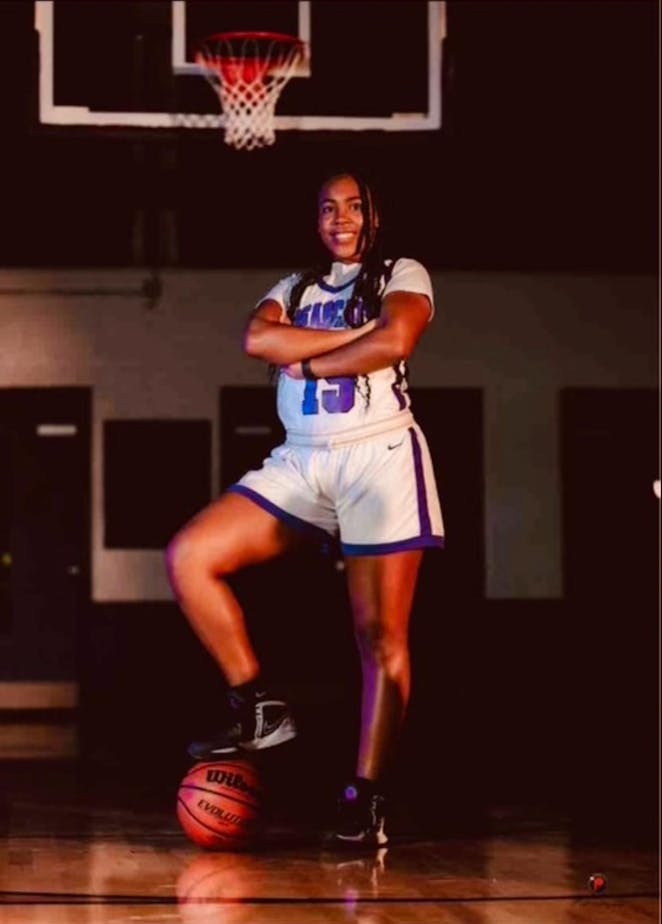
Taj Isom
The Fieldhouse and Isom’s family are synonymous with one another. First, it was Taj’s father, Duran Isom Sr. Then, it was her cousin, Jayla Scaife. After that, it was Taj’s older brother, Duran ‘BJ’ Isom Jr.
Before she took the court regularly as a key member of the Muncie Central girls’ basketball program, Taj often made the trek to the top of the Fieldhouse to get what she felt was the best view of the action.
“It felt like going to a Pacer game,” Taj said.
Yet it’s not the size of the venue that makes it special to Taj, it’s the consistent fan support. Even after four years of action on the heralded hardwood, Taj often puts herself in the headspace of a former fan in the bleachers.
“It feels nostalgic,” Taj said. “Every time I'm playing, I think about when I was sitting up there and saying, ‘Man, I wish I could be down there.’”
With countless hours spent in the Fieldhouse, Taj said her favorite moment was one of her last. It was a January evening, senior night against Muncie-Burris.
Although seeing boundless support from her family in the stands made it so Taj couldn’t wipe the smile off her face, the moment that sticks out the most came during gametime.
“I remember I did a Eurostep, and I made the bucket and everybody was like ‘Ooooh!’” Taj said. “I don't know if it’s just the lighting on the court, [but] you feel like you're shining.”
Despite running up and down the stairs for conditioning practice being the activity she most associates with the venue, Taj said she doesn’t feel like she has taken her experiences in the Fieldhouse for granted.
In fact, she advises future Bearcats to “recognize the love.”
Eric Gordon
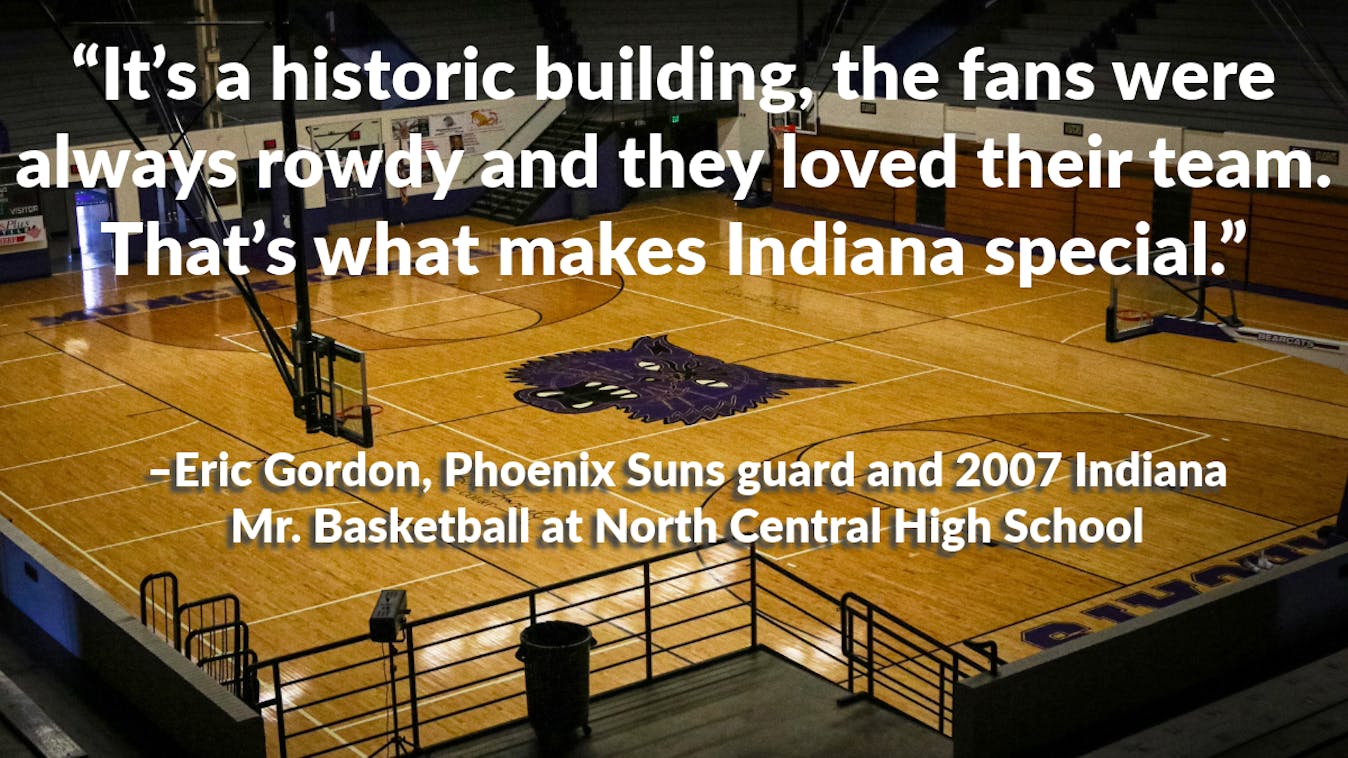
More than 18 years later, this 16-season NBA veteran still remembers the one and only time he played at the Muncie Fieldhouse. It was Jan. 21, 2006, and Gordon said his North Central Panthers were going into the historic venue with something to prove, having lost to the Bearcats by 11 at home the season prior.
“We wanted to play all the best teams in the state, and Muncie Central was always one of the harder places to play,” Gordon said.
The Panthers emerged 69-43 winners 32 minutes later. Despite the blowout victory, the energy from Muncie Central supporters at the Fieldhouse that night sticks with Gordon to this day.
“It’s a historic building, the fans were always rowdy and they loved their team,” Gordon said. “That’s what makes Indiana special.”
In fact, Gordon said it was playing in gyms like the Muncie or New Castle Fieldhouse that prepared him for his lone season calling Assembly Hall home at Indiana University and eventually playing in more than 30 NBA arenas across the nation.
However, he was sure to credit the Crossroads of America as the biggest reason he has been able to have such a long basketball journey, earning awards such as 2007 Indiana Mr. Basketball and 2016-17 NBA Sixth Man of the Year.
“I loved growing up in Indiana,” Gordon said. “If you wanted to be a basketball player during my time, that’s where you wanted to be.”
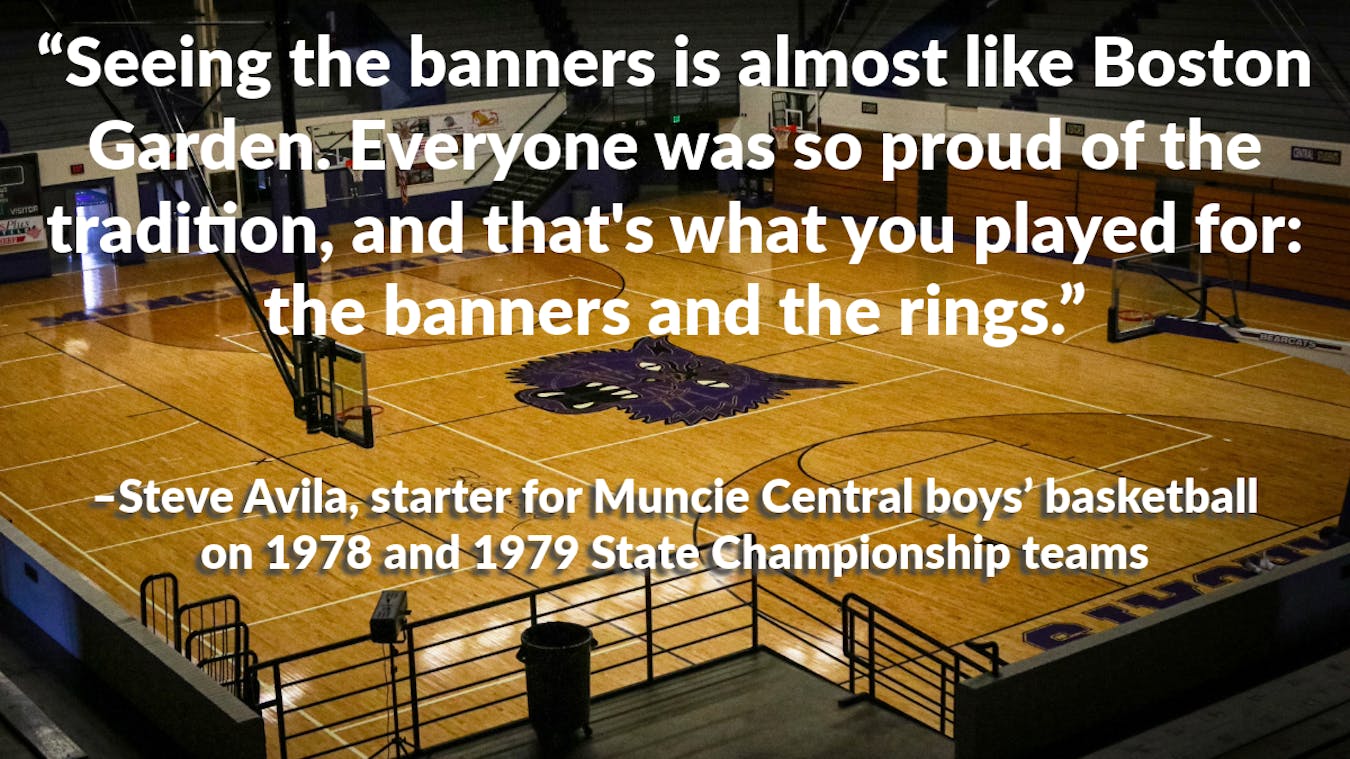
Steve Avila
A starter on Muncie Central’s back-to-back State Championship teams in 1978 and 1979, Avila said every time he walks into the Fieldhouse feels like walking into the Boston Celtics’ home court.
“Seeing the banners is almost like Boston Garden,” Avila said. “Everyone was so proud of the tradition, and that's what you played for: the banners and the rings.”
Avila’s Fieldhouse legacy began even before taking the court. His father, Ramon, joined the legendary Morrie Mannies on WLBC from 1967-1987 for radio broadcasts of Muncie Central games at the Fieldhouse.
Steve still remembers sitting in the stands as a young child, listening to the two Hall of Famers as he watched basketball on the same floor he would one day helm.
“After every basket everybody was going crazy, like they still do today,” Avila said.
Forty-four years after graduating from Muncie Central, Avila stood in the middle of the Fieldhouse’s Memorabilia Room and traded stories with 1969 graduate and president of Muncie Central’s Alumni Association David Wilson. The two laughed as they shared stories about Muncie Central vs. Muncie Southside rivalry games or making snowballs in the bleachers due to one of the upper windows being broken during the winter in the late ‘60s.
Jeff Weller
Weller’s first trip to the Fieldhouse was as a student manager for Richmond. Although the Devils held their games in the historic Richmond Civic Hall at the time, Weller knew the Muncie Fieldhouse was special as a teenager.
However, he didn’t realize how he would eventually call the press box at the top of the historic venue a second home. Weller even remembers the first time he made his way up to his seat.
“I looked through that glass window, and I'm like, ‘Oh, my God, I can't see the [jersey] numbers,’” he said. “I got used to it, in fact, I loved it up there, because we were kind of in the crowd, but I can remember almost swallowing my gum because I've gotta call who's got the ball and I can't read the numbers.
“It was always an adventure at the Fieldhouse.”
During his 20-year tenure calling high school games on WLBC with Mannies, Weller not only narrated much of the Bearcats’ most recent State Championship in 1988, but he became a historian of the program's history. All of this came down to a love for Muncie Central’s home court; A sanctuary Weller feared he may lose after the 2017 tornado.
“That's like tearing down Wrigley Field or Fenway Park,” Weller said. “Thank God it’s still here.”
Paul Dytmire
Although he graduated from Wapahani High School, Dytmire has spent more than double his time there at Muncie Community Schools (MCS). The current facilities director for the corporation, Dytmire said he started out mowing lawns for MCS properties three days after graduating high school in 1990.
He progressed to a day custodian at Muncie Central High School for 17 years, then took a job as a maintenance manager before stepping into his current role five years ago. Custodial and maintenance jobs are ingrained into the Dytmire family, as Paul said his first memories of the Muncie Fieldhouse were when his father worked in maintenance at the venue.
However, Dytmire has never been infatuated with sports, giving the Fieldhouse a different meaning for him; His fondest memories of the landmark came during his childhood when Christmas trees were sold in the Fieldhouse.
The reason why he had a connection to the Fieldhouse was irrelevant when a tornado substantially damaged the structure in November 2017, because he was determined to help the Fieldhouse return to use as a member of the crew that helped repair the damages. The Fieldhouse was back to usable shape by December 2019.
Despite the initial public concern that the near 90-year-old building (at the time) would be torn down due to the damages, Dytmire is proud to have been a part of ensuring the Muncie community kept their landmark.
“I don't think anybody in this town would have stood by and let that happen,” Dytmire said. “When you say, ‘Muncie,’ you usually know two things: Ball State University and the Muncie Fieldhouse.
“It’s like Muncie’s Buddha. If they had a place to go up and light incense, that’s what it is.”

Don Wafer
Despite the man simply known as “Wafe” being so ingrained in the culture of Muncie Central, he didn’t spend meaningful time in the Muncie Fieldhouse until his early 30s.
However, after beginning his current role as bookkeeper for the Bearcats during the 1987-88 season, his perception of the area soon changed. Tracking nearly every game Muncie Central boys’ basketball played for more than 35 years, Wafer cited stories watching the Bearcats clash against the likes of Shawn Kemp, Damon Bailey, Mike Conley and Greg Oden.
Yet it was for Muncie Central highlights that Wafer expressed the most enthusiasm, crowing about “sensational” dunks from Thompson or the 50th anniversary game between Milan and Muncie Central at the Fieldhouse broadcast on ESPN. What has made moments like these even more special for Wafer, he said, is that he has “the best seat in the house.”
“What an environment,” Wafer said. “There’s so much history there.”
Wafer expressed the same sentiment as many other Bearcats when he was inducted into the Delaware County Sports Hall of Fame in 2016: ‘I bleed Purple.’ Yet what Wafer loves most about the Fieldhouse is its diversity.
“It’s not just about Muncie Central, but it’s for the community and the county,” Wafer said.
Contact Kyle Smedley with comments via email at kyle.smedley@bsu.edu or on X @KyleSmedley_.





